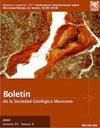火微相和焦渣追踪大气电气化对莫切河谷和莫奇卡(秘鲁北部)的影响
IF 0.4
4区 地球科学
Q4 GEOLOGY
引用次数: 0
摘要
通过比较莫切河谷(秘鲁北部海岸)全新世晚期形成的冲积土和占领层,研究了占领期间环境事件对生活条件的影响。微观上下文研究包括(1)现场微观表面识别;(2) 薄片的微观形态分析;(3) 基于数字立体显微镜和扫描电子显微镜分析的土壤成分多尺度表征。冲积序列由6 m厚的有机粉质粘土、细砂质地层和保存完好的灰炭层以及块状灰色砂层组成。这种周期性模式反映了稳定期的交替,芦苇床植被茂密,经常受到野火和干旱的影响,在厄尔尼诺事件期间,海岸沙丘的沙子入侵是其特征。公元前14世纪的日期表明,这些对比鲜明的条件持续了一千年,直到公元前300年在华卡建立了莫奇卡帝国。在烧制表面回收了土壤成分闪速熔化产生的气泡状炉渣、生物源石英和芦苇植被闪速电离形成的纳米结构聚合物,所有这些都带有FeCrNi金属涂层。它们追踪了带电粒子对土壤表面的影响、闪电、通过增强大气带电产生的纳米气溶胶,即闪光加热、冲击蒸发、植被和宿主基质的等离子体聚合。研究表明,在Huaca de la Luna山脚下的基底Uhle平台占用矿床中,出现了类似的胶结灰微相,与带有礼器中的食物和有趣的焦渣的陪葬矿床有关。仪式上处理不朽的死亡祭品的证据被解释为莫奇卡人对闪电触发等离子体过程产生的长寿材料的认识的纪念记录。这项对环境和文化背景的综合研究驳斥了以前对可耕地冲积平原进行长期工程以抵御沙子入侵和暴雨的假设。相比之下,Moche金字塔的建立被证明是在洪泛平原稳定时期发生的,其特点是高能自然事件和闪电过程为获得具有重要社会价值的耐用土壤资源提供了途径。本文章由计算机程序翻译,如有差异,请以英文原文为准。
Fire microfacies and pyroresidues tracing atmospheric electrification impacts on the Moche Valley and on the Mochica (North Peru)
The effects of environmental events on living conditions during occupation periods are studied by comparing alluvial soils and occupation floors that formed during the late Holocene in the Moche valley (North Peruvian coast). The microcontextual study comprises (1) microsurface identification in the field; (2) micromorphological analysis of thin sections; (3) multi-scale characterization of soil components based on digital stereo microscope and scanning electron microscope analysis. The alluvial sequence consists of a 6 m thick alternation of organic silty-clay, fine sandy strata with well-preserved ashy charcoal strata and massive grey sandy beds. This cyclical pattern reflects alternation of stable episodes with a dense reed-bed vegetation, regularly affected by wildfires and drought marked by sand invasions from coastal dunes during El Niño events. The 14C dates show that these contrasting conditions lasted for one millennium up to establishment of the Mochica empire at the Huaca at 300 years cal. BC. Vesicular slags produced by flash-melting of the soil components, biosourced quartz and nanostructured polymers formed from flash-ionization of the reed vegetation, all with FeCrNi metals coatings, were retrieved in the fired surfaces. They trace impact at the soil surface of electrically charged particles, lightning-flashes, nanoaerosol production by enhanced atmospheric electrification, i.e., flash-heating, shock vaporization, plasma-polymerization of the vegetation and the host matrix. The study shows the occurrence in the basal Uhle platform occupation deposits at the foot of the Huaca de la Luna of similar cemented ashy microfacies associated with a funerary deposit with food offerings in ritual vessels and an intriguing scoriaceous slag. The evidence for ritual disposal of imperishable offerings to deaths is interpreted as the memorial record of the Mochica knowledge of long-lived materials produced by lightning-triggered plasma processes. This integrated study of the environmental and cultural contexts refutes previous assumptions of long-term engineering of the arable alluvial plain to counteract sand invasion and torrential floods. In contrast, the establishment of the Moche pyramids is shown to have occurred during a period of floodplain stability marked by high-energy natural events and lightning processes that offered access to durable soil resources of important social values.
求助全文
通过发布文献求助,成功后即可免费获取论文全文。
去求助
来源期刊
CiteScore
1.40
自引率
12.50%
发文量
34
审稿时长
50 weeks
期刊介绍:
The Boletín de la Sociedad Geológica Mexicana is a completely free-access electronic journal published semi-annually that publishes papers and technical notes with its main objective to contribute to an understanding of the geology of Mexico, of its neighbor areas, and of geologically similar areas anywhere on Earth’s crust. Geology has no boundaries so we may publish papers on any area of knowledge that is interesting to our readers.
We also favor the publication of papers on relatively unfamiliar subjects and objectives in mainstream journals, e.g., papers devoted to new methodologies or their improvement, and areas of knowledge that in the past had relatively little attention paid them in Mexican journals, such as urban geology, water management, environmental geology, and ore deposits, among others. Mexico is a land of volcanos, earthquakes, vast resources in minerals and petroleum, and a shortage of water. Consequently, these topics should certainly be of major interest to our readers, our Society, and society in general. Furthermore, the Boletín has been published since 1904; that makes it one of the oldest scientific journals currently active in Mexico and, most notably, its entire contents, from the first issue on, are available online.

 求助内容:
求助内容: 应助结果提醒方式:
应助结果提醒方式:


